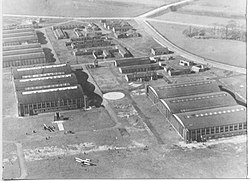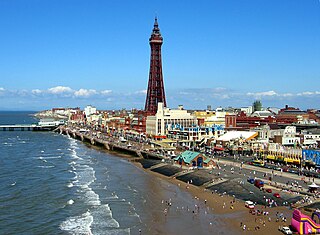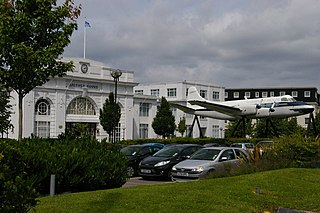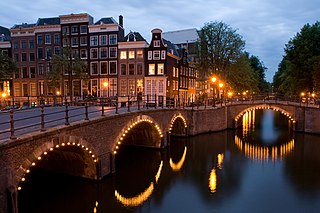
Imperial Airways was the early British commercial long-range airline, operating from 1924 to 1939 and serving parts of Europe but principally the British Empire routes to South Africa, India and the Far East, including Malaya and Hong Kong.

Withington is a suburb of south Manchester, England. Historically part of Lancashire, it lies 4 miles (6.4 km) from Manchester city centre, about 0.4 miles (0.6 km) south of Fallowfield, 0.5 miles (0.8 km) north-east of Didsbury and 1 mile (1.6 km) east of Chorlton-cum-Hardy. Withington has a population of just over 14,000 people, reducing at the 2011 census to 13,422.
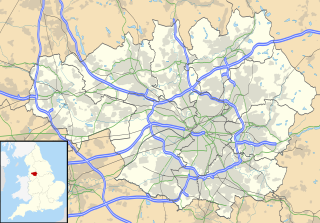
Whalley Range is an area of Manchester, England, about 2 miles (3.2 km) southwest of the city centre. The population at the 2011 census was 15,430. Historically in Lancashire, it was one of the earliest of the city's suburbs, built by local businessman Samuel Brooks (1793–1864).

City Airport is an airport in Barton-upon-Irwell, Greater Manchester, England, 5 nautical miles west of Manchester. Formerly known as Barton Aerodrome and City Airport Manchester, It is known by the Civil Aviation Authority (CAA) as Manchester/Barton.

RAF Ringway was a Royal Air Force station in Ringway, Cheshire, England, near Manchester. It was operational from 1939 until 1957. The site of the station is now occupied by Manchester Airport.
Railway Air Services (RAS) was a British airline formed in March 1934 by four railway companies and Imperial Airways. The airline was a domestic airline operating routes within the United Kingdom linking up with Imperial's services.
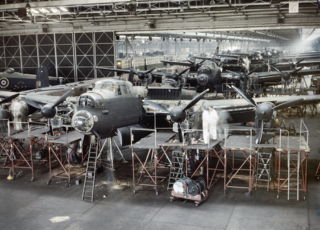
Woodford Aerodrome or Manchester Woodford Aerodrome(ICAO: EGCD) is a former private airfield and aircraft factory located at Woodford, Greater Manchester. The site, which is 6 NM north of Macclesfield, Cheshire, England, was opened by the Avro company shortly after the First World War. It became an important production centre for military aircraft during the Second World War. Notable planes made at the factory include the Avro Anson, Avro Lancaster, Avro Shackleton and Avro Vulcan.

Heston Aerodrome was an airfield located to the west of London, England, operational between 1929 and 1947. It was situated on the border of the Heston and Cranford areas of Hounslow, Middlesex. In September 1938, the British Prime Minister, Neville Chamberlain, flew from Heston to Germany three times in two weeks for talks with Adolf Hitler, and returned to Heston from the Munich Conference with the paper referred to in his later "Peace for our time" speech from 10 Downing Street.
The Lancashire Aero Club is the oldest established flying club in the United Kingdom.

Hough End Hall is a historic house now in Chorlton-cum-Hardy,, Manchester, North West England. It was built in 1596 during the reign of Queen Elizabeth I by Sir Nicholas Mosley, when he became Lord of the Manor of Manchester and of the dependent Manor of Withington. The Mosleys were an influential Mancunian family from the 16th century onwards, and prominent in the affairs of the Manchester district for two and a half centuries.
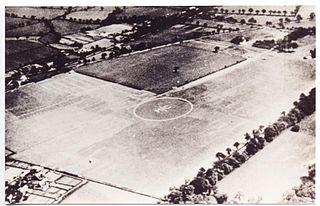
Manchester (Wythenshawe) Aerodrome also known locally as Rackhouse Aerodrome was the first airfield built to serve, temporarily, as Manchester's municipal aerodrome.
Trafford Park Aerodrome (Manchester) was the first purpose-built airfield in the Manchester area. Its large all-grass landing field was just south of the Manchester Ship Canal between Trafford Park Road, Moseley Road and Ashburton Road and occupied a large part of the former deer park of Trafford Hall. Today's Tenax Road runs north-south through the centre of the site of the old airfield, which was 0.7 miles northeast of today's Trafford Centre.
John Fishwick Leeming was an English entrepreneur, businessman, early aviator, co-founder of the Lancashire Aero Club, gardener and author.
National Aircraft Factory No. 2 was a World War I UK government owned aircraft factory located at Heaton Chapel, Stockport. It produced over 450 warplanes during 1918/19.

Lympne Airport, was a military and later civil airfield, at Lympne, Kent, United Kingdom, which operated from 1916 to 1984. During the First World War RFC Lympne was originally an acceptance point for aircraft being delivered to, and returning from, France but was later designated as a First Class Landing Ground, RAF Lympne. It became a civil airfield in 1919 and saw the operation of early air mail services after the 1918 armistice. It was one of the first four airfields in the United Kingdom with customs facilities.
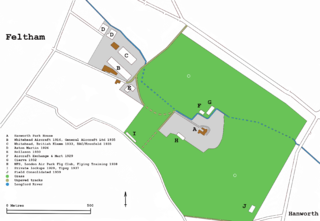
London Air Park, also known as Hanworth Air Park, was a grass airfield in the grounds of Hanworth Park House, operational 1917–1919 and 1929–1947. It was on the southeastern edge of Feltham, now part of the London Borough of Hounslow. In the 1930s, it was best known as a centre for private flying, society events, visits by the Graf Zeppelin airship, and for aircraft manufacture by General Aircraft Limited (GAL) 1934–1949.

Hounslow Heath Aerodrome was a grass airfield, operational 1914-1920. It was in the London borough of Hounslow, and hosted the British Empire's first scheduled daily international commercial flights, in 1919. The site today includes the main remaining part of Hounslow Heath.
Construction started on Ringway on 28 November 1935 and it opened partly in June 1937 and completely on 25 June 1938, in Ringway parish north of Wilmslow, from which it derived its name Manchester (Ringway) Airport. Its north border was Yewtree Lane. Its southeast border was a little northwest of Altrincham Road (Styal).
